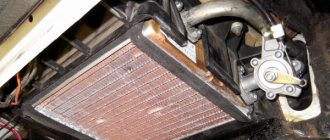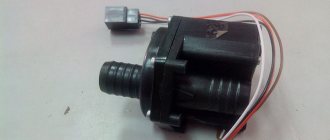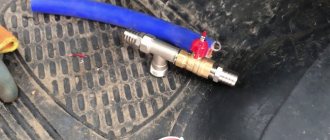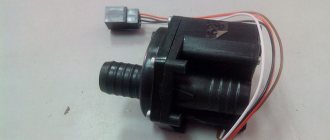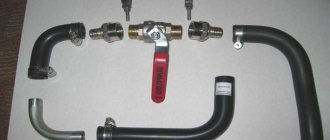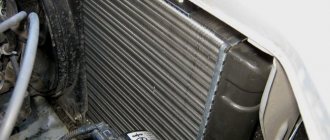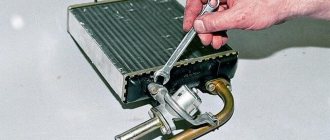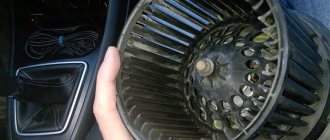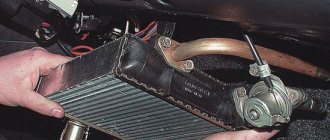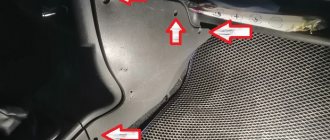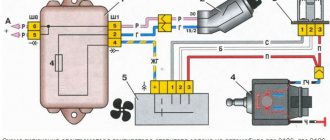The VAZ 2107 heater valve is an element of the cooling system and is designed to regulate the supply of coolant to the heater radiator.
In its open position, hot antifreeze or antifreeze enters the radiator, which heats the air pumped by the fan. This way the interior is heated during the cold season.
During the warm season, the tap is turned off, which causes the coolant to bypass the “stove” without affecting the temperature in the cabin. All domestic “classic” cars, as well as VAZ 2108, 2109, 2110, 2113-15, are equipped with such a crane.
CHANGING THE HEATING VALVE FOR A VAZ 2107
Having discovered a leaking faucet, the owner of the “seven” will be forced to replace it. This device cannot be repaired, since it is not possible to find spare parts for the VAZ membrane valve on sale (and besides, it is very difficult to disassemble the body of the standard membrane valve on the “seven” without breaking it). So there is only one option left: replacing the part. But before we start, let's decide on the tools. Here's what we need:
- set of spanners;
- pliers;
- crosshead screwdriver;
- new fuel valve for VAZ 2107 (preferably ceramic).
SEQUENCE OF OPERATION
First of all, you need to turn off the engine of the VAZ 2107 and cool it well. This usually takes 40 minutes. Without this preparatory operation, any touch to the heating tap can lead to serious burns to your hands.
Now the interior of the car opens. The screws holding the storage compartment and glove compartment are unscrewed. The glove compartment is carefully removed from the niche, allowing access to the fuel tap from the passenger compartment.
The hose through which antifreeze enters the heating radiator is removed from the tap pipe. To do this, the clamp that holds the pipe is loosened with a screwdriver. After this, the hose is pulled off the pipe manually.
Now you should open the hood of the car. Just below the windshield, in the partition of the engine compartment, there are two hoses connected to the fuel tap. They are also held on by steel clamps, which can be loosened with a screwdriver.
After this, the hoses are removed from the nozzles manually. When removing them, extreme care must be taken: antifreeze almost always remains in them. And if the driver has not cooled the engine well, the antifreeze will be hot.
Now you need to unscrew the fuel valve fasteners. The faucet is held on by two 10mm nuts, which can be easily unscrewed with a regular open-end wrench. Having unscrewed the tap, it must be left in the niche.
In addition to the hoses, a cable is also connected to the fuel tap, with which the driver opens and closes the tap
The cable has a special fastening end with a 10 nut, which is unscrewed with the same open-end wrench. The cable is removed along with the tip.
Now the fuel valve is not held in place and can be removed. But first you need to pull out the large gasket that covers the niche with the pipes (this gasket is removed from the passenger compartment).
After removing the gasket, the valve is pulled out of the engine compartment and replaced with a new one. Next, the VAZ 2107 heating system is reassembled.
Common fuel valve malfunctions
All malfunctions of the fuel valve on the VAZ 2107 are in one way or another related to a violation of the tightness of this device. Let's list them:
- The fuel valve started leaking. It’s impossible not to notice: a large puddle of antifreeze forms under the feet of the passenger sitting in the front seat, and a characteristic chemical smell spreads throughout the car’s interior. As a rule, a leak occurs due to the fact that the membrane in the fuel tap has become completely unusable. This is usually observed after two to three years of operation of the crane;
- The fuel valve is stuck. It's simple: the diaphragm fuel valve mentioned above is susceptible to oxidation and corrosion. Almost all drivers in our country close this tap in the warm season. That is, at least three months a year the tap remains in the closed position. And these three months are quite enough for the rotary rod in the faucet to oxidize and become firmly “stuck” to the body of the device. Sometimes it is possible to turn such a rod only with the help of pliers;
- antifreeze leaking from under the clamps. On some “sevens” (these are, as a rule, the latest models), the valve is attached to the pipes with steel clamps. These clamps weaken over time and begin to leak. And this is perhaps the most minor problem with the fuel tap that a car enthusiast may encounter. To solve it, simply tighten the leaking clamp with a flat screwdriver;
- The faucet does not open or close completely. The problem is due to internal contamination of the device. It is no secret that the quality of antifreeze on the domestic market of fuels and lubricants leaves much to be desired. In addition, counterfeit coolant is also found (as a rule, antifreeze from well-known brands is counterfeited). If the driver is used to saving on antifreeze, then gradually the fuel tap becomes clogged with dirt and various chemical impurities, which are present in abundance in low-quality antifreeze. These impurities form hard lumps that do not allow the driver to turn the valve stem all the way and completely close (or open) it. In addition, low-quality antifreeze can cause rapid corrosion of the internal parts of the standard "seven" diaphragm valve, and this can also prevent the fuel valve from being tightly closed. The solution to the problem is obvious: firstly, remove and thoroughly rinse the clogged tap, and secondly, use only high-quality coolant.
When is it necessary to change?
The car heater valve is designed to regulate the supply of coolant. If it is open, the coolant enters the radiator in a heated state and heats the air coming from outside, circulating thanks to the fan. The heated air serves to heat the interior in winter. In the summer, the tap shuts off the flow of coolant into the radiator, and it goes bypassing the stove, so it does not affect the microclimate of the cabin.
Heater valve VAZ 2107
Replacing the heater tap is necessary if it becomes jammed. This occurs due to oxidation of the locking mechanism, as well as contaminants that are deposited on the internal walls.
Often the stove faucet has to be replaced if it begins to leak, which is a consequence of depressurization of its body. In this case, the coolant level in the expansion tank decreases, a wet spot appears on the floor under the front passenger’s feet, which is formed due to a leak, and a specific smell of antifreeze or antifreeze appears.
Basically, the body of the heater valves cannot be disassembled, so their repair is impossible. If a malfunction is detected, the part must be replaced (video author: Jena Pon).
About the wealth of choice and a worthy alternative
Over the many years of operation of the VAZ 2107, the valve for the stove had to be changed more than once. I tried absolutely everything that is on sale:
- expensive and cheaper;
- factory and cooperative;
- regular and ball.
But a year or two passed, the faucet began to leak or became tightly jammed and everything started all over again. The latest acquisition in this area was the purchase of a heater tap with a ceramic shut-off element, the so-called ceramic heater tap. I immediately liked the faucet for its complete absence of any kind of play, absolute smoothness of operation and visual quality of execution, which is atypical for this category of products. The price, by the way, was also quite reasonable.
Repair of the VAZ-2107 heater or why the “stove” does not heat?
Why does the VAZ-2107 stove not heat up? And again the weather threatens with cold weather. For those who have problems with their heater, the most important question is how to make the “stove” heat up? First of all, let's determine the cause of the malfunction. The culprit may be an underheated engine, an airy cooling system, or a malfunction of the heater itself. If the stove fan does not spin, the electrical wiring is faulty - see here.
Often, the cause of cold in the cabin is an underheated engine.
Signs: the temperature on the gauge is in the white zone, the engine takes a long time to warm up. Normal warming up at a temperature of -20 looks like this: start the engine, in 8-10 minutes at idle the engine should warm up to 40-50 degrees (the very beginning of the white sector of the temperature gauge scale). If the temperature rises higher, it’s good, less is bad. Thermostat is faulty. Then we drive in 1-2 gear, and in 5-8 minutes the temperature rises to 80 (the border of the white and green zones). The thermostat did not warm up to 80 - the thermostat needs to be replaced! Temporarily, you can get by with insulating the radiator with cardboard or something else. But don’t forget that if you put a load on the engine (it’s stuck and slipping), it can boil. Therefore, the cardboard should be pulled out easily and quickly.
Air in the cooling system
First of all, we check the antifreeze level in the expansion tank and the serviceability of the radiator cap. If the antifreeze is diluted with water, it’s bad, it will harden, it needs to be replaced. If the radiator cap is faulty, air will remain in the system, and this will lead to poor circulation and coldness in the cabin. We buy and install a new plug, add antifreeze and the deficiency disappears.
An air lock may remain even after repairing the cooling system. Remove the air by driving the car, preheated to 80 degrees. engine, uphill to raise the front end. Then, having removed the radiator cap, drive the engine at 2000 - 3000 rpm for several minutes. After the air comes out, all that remains is to add antifreeze and close the radiator cap.
Next, check the correct position of the stove control levers
Blue - controls air supply. Red - antifreeze supply tap. They must be open (all the way to the right). Sometimes the tap turns sour. Find it under the glove compartment and check - it should open all the way, you can help with your hand, simultaneously with the lever. Just work carefully, the parts are thin and fragile and can be broken. It is convenient to move the lever with your left hand and turn the tap with your right.
VAZ 2107 heater valve in the open position
Heater valve in closed position
We check the operation of the air damper with the fan turned on. The lever to the right from the stove blows strongly, to the left it blows much weaker. If there is no difference, it’s bad - the cable has come off, the stove will have to be removed.
Stove design
The stove consists of the following parts:
- Heater, a stove radiator is installed in it (indicated by the number 5 in the figure), it heats the air penetrating from outside;
- The stove fan, or motor (indicated by the number 14 in the figure), it pumps a flow of warm air into the cabin, it is mounted in a special casing (indicated by the number 16 in the figure) on elastic cushions that dampen its vibration;
- The stove control system is a fan button (indicated by the number 18 in the figure), three control knobs for heating modes - blowing onto the windows, taking air from the cabin or from the street, and opening and closing the stove tap.
1, 9 – air ducts for heating the side windows on the left and right; 2 — air duct for heating the windshield; 3 — radiator casing; 4 — air intake cover; 5 — heater radiator; 6 — radiator valve; 7, 8 radiator hoses for supplying and discharging hot fluid from the cooling system; 10 — rotary deflectors; 11 — air duct damper; 12 — air distribution cover; 13 — fan guide casing; 15 — lever of the air distribution cover; 17 — control rods; 19 - central air duct.
The heating system works in the following order:
- Air for heating comes from outside, through air intakes on the hood.
- Under the hood there is a special box, insulated with a rubber seal, for air flow.
- From it the air flow is directed to the stove.
- Next, the air is heated by a radiator, which is fed with antifreeze and antifreeze. The degree of heating is regulated by the heater tap. The faucet is controlled by a flexible rod using a control lever.
- At high vehicle speeds, air can enter the passenger compartment without the fan being turned on. Therefore, at high speed you can use the stove without additional load on the car’s electrical network. The interior heater is turned on by a fan switch that has three positions - neutral and two speeds: low and high. Speeds are provided by a resistor; it increases the resistance of the circuit and reduces the speed of the fan.
- The fan accelerates the warm air flow through the air ducts to the sides, onto the side windows for good visibility of the rear-view mirrors, and into the grille deflectors, which can change the direction of the air flow for better airflow. There is also a flow of warm air through the air duct to blow on the windshield.
Above in the figure, blue shows the circulation diagram of cold air flows, and orange shows the movement diagram of warm air flows. Main parts of the heating system:
1 — air distribution cover; 2 – fan electric motor; 3 – fan, impeller housing; 4 – heater tap; 15 – radiator.
The stove is controlled:
- Changing the position of the lower cover of the fan casing using a lever (down-up);
- Changing the position of the control unit levers (heating flaps of the side windows and windshield, air supply covers).
What breakdowns most often occur in the heating system?
- Leaking radiator tap, pipes, radiator housing;
- Malfunction of electrical equipment (fuse, mode switch, oxidation of wires, motor). The fan fuse is located in the mounting fuse block numbered F1 with a rating of 10A; below is a diagram of the mounting block.
Replacing the stove faucet
On a VAZ 2107 car, sometimes the faucet may leak or even become sour. They have to be used intensively and therefore often fail. Before you start replacing the faucet, purchase a set of gaskets for it. The tap is changed when the engine has cooled down.
Replacement sequence:
- Loosen the clamp of the inlet pipe (lower) and remove it from the tap;
- Use the lower lever in the control unit to close the dampers;
- Remove the glove compartment;
- We dismantle the air duct behind the glove compartment - to do this, disconnect it from the side deflector and remove it from the heater housing. Now, using a 7 key, loosen the crane rod and remove it.
Using a 10mm wrench, unscrew the valve from the radiator;
- We disconnect the pipe and remove the heater valve; antifreeze may leak, it should be collected in a container;
- Using a 10mm wrench, unscrew the pipe from the faucet;
We disconnect the tap and the pipe. That's all, the removal of the tap is completed.
Why might the stove not heat up?
So, the stove does not work, it blows cold air. Since this system is quite simple, there are not many possible breakdowns, and many of them can be eliminated without incurring huge costs.
Main malfunctions and ways to eliminate them:
- Airing the system. If the antifreeze has recently been replaced, there may be an air lock in the stove system, as a result of which it will heat very poorly. In this case, you need to open the heater valve, and then carry out the standard procedure for removing air from the cooling system.
- There is scale on the heater tap, which prevents antifreeze from flowing through it. A faulty faucet prevents you from turning the stove on or off. Plain water may be the culprit of the problem if the car owner used it as a coolant in the summer. Deposits clog the tap hole and it has to be cleaned or replaced.
- There is scale or dirt in the heater radiator, while the underwater pipe is hot and the outlet pipe is cold. The formation of sediment is a natural process, even if you use only high-quality antifreeze. But VAZ drivers often make do with plain water, which causes corrosion of the metal elements of the cooling system. Rust settles in radiators and gradually damages them. You will have to remove the stove and try to clean it, and if that doesn’t work, then replace it.
- The pump does not pump. This is already serious, and is fraught with not only discomfort during the trip, but also overheating of the engine. The pump breaks down from scale deposited on it, the impeller can be worn down by solid particles and simply fail due to age. You need to check the condition of the drive belts, and if they are in order, replace the pump itself.
- In the heater radiator, the heat exchanger partition, which distributes the flow of liquid, has shifted. In this case, the antifreeze will enter the side tank of the radiator and immediately exit through the second pipe, without entering the honeycomb, then both pipes will be hot, and the radiator itself will be cold. It will have to be replaced; it cannot be repaired.
Only two new ones are better than new
A little higher, I already mentioned in passing that replacing the heater tap in a Zhiguli is a complex procedure. That is, along with the tap, the short pipe also changes (you can, of course, not do this, but its low cost still speaks in favor of replacement). Moreover, technologically you still have to screw this pipe to the faucet, so it’s better to screw a new one. And just for the sake of curiosity, just look into the old one to see how much its throughput has been reduced due to solid deposits.
Another part, the replacement of which is also necessary and care when purchasing which is very important, is the rubber gasket. You need two of them and both need to be chosen very carefully. The photo shows what unscrupulous sellers can sell in the store. Therefore, you can insure yourself in only two ways, and it is advisable to combine them:
- 1. When purchasing, inspect the gasket very carefully for peeling, microcracks, tears and other defects;
- 2. Buy a dozen of these pads - they’re inexpensive, they don’t take up much space, they don’t ask you to eat or drink, and if something happens, there’s nothing to replace them with.
Disassembling the stove faucet
Purpose and principle of operation of the heater tap on the VAZ 2107
In short, the purpose of the stove tap is to give the driver the opportunity to switch between “summer” and “winter” modes of heating the interior. To understand what we are talking about, you need to understand how the heating system of the “seven” works.
The fuel taps on all “sevens” without exception were membrane valvesSo, the VAZ 2107 engine is cooled by antifreeze circulating in the so-called jacket. Antifreeze passes through the jacket, picks up heat from the engine and heats up to a boil. This boiling liquid must be cooled somehow. To do this, antifreeze is directed through a system of special pipes from the jacket to the main radiator, which is continuously blown by a massive fan.
The 7 engine cooling system has two radiators: the main one and the heating one.
Passing through the main radiator, the antifreeze cools and goes back into the engine for the next cooling cycle. The radiator (which in the early “sevens” was made exclusively of copper) becomes very hot after antifreeze passes through. And the fan, which continuously blows on this radiator, creates a powerful flow of hot air. In cold weather, this air is directed into the cabin.
In addition to the main radiator, the “seven” has a small heating radiator. It is on this that the heating tap is installed.
The heating valve on the “seven” is attached directly to the stove radiator
In winter, this tap is constantly open, so that hot antifreeze from the main radiator goes to the stove radiator, heating it too. The small radiator has its own small fan, which supplies heated air directly into the car’s interior through special air lines.
The heating system of the “seven” has its own fan and a complex system of air ducts
In summer there is no need to heat the interior, so the driver closes the heating tap. This makes it possible to use a heating fan without heating the interior (for example, for ventilation, or when the windows are fogged up). That is, a heating tap is necessary to quickly switch between small and large antifreeze circulation circles in the “seven” heating system.
Forward and reverse sequence
Replacing the stove tap itself does not cause any difficulties. You need to start working when the engine has cooled down by disconnecting the supply and return pipes. Then carefully and carefully provide access to the tap by removing the shelf and glove compartment body. The seven differs from other classics in that it still has the right air duct in that place, which you also cannot do without removing. Now, everything is actually ready to replace the tap:
- unscrew the cable fastening and remove its tip from the lever;
- unscrew the two nuts that secure the faucet to the stove;
- put a rag down, because when removing the tap, a small part of the antifreeze is guaranteed to leak;
- remove the tap with the adapter for the supply pipe.
We install the tap with the adapter pre-screwed to it in the reverse order, carefully monitoring the accuracy of the connections and the tightness of the entire structure. Before fixing the cable, make sure that the control lever opens and closes the stove valve all the way. And at the very end, don’t forget to add antifreeze to the cooling system and enjoy the well-deserved warmth inside your car.
Stages of cleaning the stove on a VAZ-2107
If you follow the recommendations and follow the work plan that we have given below, then cleaning the stove will be done the first time and will not take much time.
Preparing tools and supplies
To clean the stove in a short time, you need to prepare the necessary tools and consumables in advance. For work we will need:
- a pair of rubber gaskets;
- a pair of worm clamps;
- cooling liquid;
- a container in which the coolant will be collected;
- set of wrenches.
Instructions for cleaning the stove
When all the necessary elements are prepared, you can begin to work. It will consist of several stages.
- The car engine must not only be turned off, but also cooled down. This is a mandatory condition that must be observed by car owners. Cloths must be placed under all existing pipes.
- The existing clamps in the engine compartment that are installed on the coolant inlet and outlet hoses must be loosened. The hoses that connect to the pipes on the radiator and heater tap will need to be removed, after placing a container under them to drain the coolant.
- Using a 7mm socket wrench you will need to unscrew the screws that are used to secure the seal. After the seal is removed, it is necessary to disconnect the casing on the furnace fan and the drive rod, which is located on the heater valve. The radiator pipes will need to be removed from the hole in the engine compartment partition. Now you can dismantle the radiator.
- You use a 10 mm spanner, which will allow you to unscrew a couple of bolts on the outlet pipe on the radiator. After this, you can easily remove the pipe, and with it the rubber gasket, which is located at the joints of the flanges. It needs to be replaced with a new seal. We remove the heater from the stove, or rather, the tap from it.
- Now the radiator of the VAZ-2107 stove can be cleaned, which consists of removing debris, cleaning the pipes and the heater tap. You can use a brush to clean the hoses.
- Flushing the radiator can be done in two ways. The first will require a Karcher installation and a pressure of around 5.5 atmospheres. Flushing must be continued until the water flowing out of the radiator is absolutely clean. On average, this procedure will take about 160 liters of water. If such equipment is not available, then you can use caustic soda. This solution is poured into the radiator for an hour. After this time, the liquid is drained. The liquid should pour out without changing color. The procedure is completed by blowing with compressed air using a compressor.
- All gaskets and rubber bands that were removed during operation must be replaced with new ones. Reassembling the heating system is carried out in the reverse order. Before adding cooling liquid, the heater valve must be moved to the extreme right position. When the liquid is filled, you will need to check the connections for leaks. If it is missing, you need to tighten the clamps tighter.
Carrying out replacement
The algorithm for performing the work is as follows:
- Unscrew the casing that secures the control cable.
- Remove the end of the cable from the stove faucet.
- Unscrew the nuts that secure the valve body to the radiator. Please note that antifreeze may leak out at this point, so place a dry cloth on the floor.
- Remove the old faucet.
- Remove the adapter that holds the pipe supplying hot antifreeze.
- Replace all rubber gaskets that are on the faucet.
- Install the adapter on the new device.
- Secure the valve to the radiator by tightening the mounting bolts.
- Install the control cable and ensure that the valve opens and closes completely when moving the lever.
Principle of operation
The heating system works simply - to ensure air heating, the driver uses the upper slider to open the antifreeze supply valve to the heater radiator. If the air supply damper is open (the middle slider is in the extreme right position), then the air flow through the box that separates the moisture and the damper enters the stove body. Passing through the radiator, the air heats up, and then moves depending on the location of the remaining dampers.
If the lower slider is moved to the right, then the heated air will go to the windshield area, and if it is positioned to the left, it will go to the center of the cabin and to the side windows. To supply heated air to the feet, the driver needs to lower the lower damper lever down.
When driving at high speeds, the air flow through the air intakes moves intensively, so it is not necessary to turn on the fan. But if the movement speed is not enough, the fan creates forced circulation.
Using dampers and a fan, the driver controls the stove - sets the speed of air movement, the degree of its heating and the area of distribution.
https://youtube.com/watch?v=hMBsbOiQ67s
Reasons for decreased performance
In addition to obvious malfunctions due to which the stove does not work or functions incorrectly, there are other problems with the heating system of the VAZ-2107 interior. The main one is a decrease in stove performance.
If the stove heats poorly, then the reason lies in:
- Malfunctions of the power plant cooling system (reduced pump performance, stuck thermostat).
- Radiator clogged.
- Formation of an air lock in the heater radiator.
- The air intake damper seal is worn out.
To find the cause of decreased performance, start by checking the heating of the heater radiator. To do this, heat the engine to operating temperature, fully open the antifreeze supply valve to the stove and hand check the degree of heating of the supply pipe before and after the valve and the radiator itself. If the pipeline is hot before the tap, but not after it, the tap is jammed. If the radiator does not warm up, the reason lies in severe clogging of the heat exchanger or a plug in it. If the pipeline does not warm up even to the tap, inspect the cooling system.
If the radiator warms up well, but it is noted that the stove heats worse, then check the functionality of the air intake damper and the condition of its seal. It wouldn’t hurt to check the stove body and air ducts for leaks and cracks.
To ensure that the VAZ-2107 heater heats well, before the winter period check the functionality of the tap, replace the antifreeze (with flushing the system), inspect the control mechanism and the functionality of the dampers.
Before the onset of cold weather, every responsible driver carries out a preventive inspection of the car and eliminates possible malfunctions. Most often, oil and antifreeze are changed regularly, and the car tires are changed to winter ones. The stove, which is one of the main units of the car, which provides comfort for the driver and passengers in the cold season, also requires special attention.
This article will discuss the design of the VAZ-2107 stove and its correct configuration for high-quality heating of the interior.
Replacing the heater valve VAZ 2107
Once the faucet starts leaking, it needs to be replaced. This is quite easy to do. To do this, prepare a standard set of tools and prepare to work inside the car.
https://youtube.com/watch?v=97BWnGrgRCw
Replacement procedure:
The car must be placed on a flat surface, and an empty container must be placed under the radiator. A wide trough with a capacity of at least 10 liters is ideal for this.
The width of the container is most important. Unscrew the cap located on the car radiator and drain the antifreeze from it into a pre-prepared trough. Do not leave the car during the draining process and monitor it completely, as it happens that drivers confuse a complete drain with a simple clogged drain hole
If necessary, clean it and continue draining the antifreeze. As soon as the radiator is empty, move the container under the engine and find a special bolt on the left side of the block. Unscrew it and drain the coolant from the engine cooling system. Thus, the system is freed from antifreeze and then the tap can be easily removed.
Unscrew the hoses from the heater radiator and unscrew the heater tap mounts. It is located on the right side of the stove inside the car. To get to it, you need to twist the bottom shelf. Remove the cable in advance and dismantle the old element. After the faucet is removed, clean the installation site from the remains of the old gasket and dust and install a new faucet along with a new gasket. During installation, use automotive sealant for cooling systems. This way you will save yourself from the problem of poor sealing of the fastening. Instructions for using the sealant are contained directly on its packaging. After securing the faucet and installing the cable, attach the hoses in place and tighten all drain plugs. Pour antifreeze into the cooling system and put back the lower shelf in the car.
To avoid air locks, you can use two methods. The first is to open the radiator cap and press on all the pipes going to the engine until air bubbles stop coming out from under the cap. The second method is the simplest. The car is placed on a hill with the front facing up. The radiator cap is also unscrewed, and the driver intensively gases the engine.
This completes the replacement of the heater heater valve. As you noticed, this is not a complicated procedure at all and does not require you to have much knowledge in the field of car repair and maintenance. It is enough to have a minimal understanding of how the system works.
Preparing for repairs
First of all, it is necessary to install the VAZ-2107 on an inclined surface so that the front part is lower than the rear. In this case, you will completely drain the liquid from the cooling system. To do this, you need to place a container of at least 10 liters under the engine, then unscrew the plug with a key to “13”. It is also necessary to drain the remaining fluid from the radiator.
Carry out all work only on a cooled engine. Otherwise, you can get severe burns. The liquid must be drained with the stove tap open. But if you can’t open it, you need to loosen the lower pipe and drain the liquid from it.
Replacing the heating valve on a VAZ 2107
Having discovered a leaking faucet, the owner of the “seven” will be forced to replace it. This device cannot be repaired, since it is not possible to find spare parts for the VAZ membrane valve on sale (and besides, it is very difficult to disassemble the body of the standard membrane valve on the “seven” without breaking it). So there is only one option left: replacing the part. But before we start, let's decide on the tools. Here's what we need:
- set of spanners;
- pliers;
- crosshead screwdriver;
- new fuel valve for VAZ 2107 (preferably ceramic).
Sequence of work
First of all, you need to turn off the engine of the VAZ 2107 and cool it well. This usually takes 40 minutes. Without this preparatory operation, any touch to the heating tap can lead to serious burns to your hands.
- Now the interior of the car opens. The screws holding the storage compartment and glove compartment are unscrewed. The glove compartment is carefully removed from the niche, allowing access to the fuel tap from the passenger compartment.
- The hose through which antifreeze enters the heating radiator is removed from the tap pipe. To do this, the clamp that holds the pipe is loosened with a screwdriver. After this, the hose is pulled off the pipe manually.
A little worldly wisdom
Experienced Zhiguli drivers know, but beginners should adopt one small everyday trick - in order to save themselves from many unexpected troubles, it is worth keeping a small set of spare parts in the car, the replacement of which may need to be replaced suddenly, but will inevitably occur. And on this list, among the generator brushes and old but working side light bulbs, there simply must be a new heater faucet, several gaskets and a pipe that can be screwed to the faucet at your leisure.
Faucet options for installation
How to change the heater tap on a VAZ 2107 yourself
There is an opinion among car enthusiasts that the VAZ 2107 heater valve is replaced when it leaks. This is not entirely true. In most cases, it has to be changed due to jamming, which is caused by contaminants deposited inside. And this unpleasant fact is discovered when you try to open or close it when the ambient temperature changes - in spring or autumn. Of course, there are times when the faucet starts to leak, and there is a wet spot on the carpet under the passenger’s feet, caused by leaked coolant.
In both cases, there is only one solution - immediate replacement of the heater tap. To do this, you need to purchase a new faucet (preferably ceramic), spare rubber gaskets for the faucet and pipe, and a clamp with a diameter of up to 23 mm, if you have not already installed it to replace the factory one. Some owners of VAZ cars install a regular plumbing tap instead of the standard factory heater tap. This option has a number of advantages, but it is not applicable for VAZ 2105 and 2107 cars due to the presence of air ducts that block access to it. Replacing the faucet does not require the use of special tools; you will need:
- Key to 7;
- Key for 10;
- Pliers;
- Phillips screwdriver.
Let’s immediately answer the question of what caused the replacement of a conventional faucet with a ceramic one. Practice has shown that a ceramic faucet is better, as it is devoid of all the disadvantages of a standard one. At the same time, it fully complies with all requirements, both in terms of fastenings and throughput. It is for these reasons that experts recommend replacing the standard VAZ heater tap with a new one that has a ceramic shut-off element.
Work is carried out on a cooled engine to avoid possible burns. First you need to disconnect the supply pipe under the hood.
Next, in the cabin we remove the storage shelf and the glove compartment housing, under which there is a heater tap. In VAZ 2105 and 2107 cars, to gain access to the valve, you need to remove the right air duct, while in other classic models there is no air duct.
It is necessary to remove the air duct on a VAZ 2107 especially carefully, since in addition to the fastening nut, which is easily unscrewed with a 10mm wrench, it is held tightly by latches. You should carefully remove the air duct from all latches without breaking them, otherwise the tightness of the air supply system will be compromised and, as a result, its efficiency will be reduced. If, despite all care, the air duct is damaged, it is better to replace it or carefully seal it during assembly. Next, the heater tap is directly replaced:
The bolt securing the control cable casing is unscrewed and its tip is removed from the crane lever;
- The two bolts securing the faucet to the stove are unscrewed, and two points must be taken into account: Secure the lower nut in the groove so that it does not fall out. This can be done using plasticine;
- When you remove the valve from the heater, some coolant will leak out. Therefore, it is better to place a sponge or rag under it;
- The entire structure is removed from the body;
- The metal adapter intended for fitting the supply pipe is unscrewed.
The old heater valve has been removed, you can begin installing the new one. This involves replacing the old rubber gaskets with new ones.
The work is carried out in the reverse order and should not cause any difficulties, except for one thing - when fixing the control cable casing, make sure that the movement of the heater valve control lever completely opens and closes it. Otherwise, you should adjust the fastening of the casing until a positive result is achieved. Next, you need to put on and tighten the supply pipe with a clamp.
Before you begin assembling the air duct, you must ensure that the system is tight. To do this, you need to start and warm up the engine. This way, you will ensure that there are no leaks at the heater valve mounting points and remove any possible air pockets in the cooling system. If everything is fine and the coolant does not leak, you can safely reinstall the air duct, glove box housing and shelf. Lastly, check the coolant level and add if necessary.
This completes the replacement of the stove tap. Having done this work yourself once, in the future you will be able to replace the stove faucet without any problems. You just need to remember the features of the VAZ 2105 and 2107 in case you need to replace the tap in other VAZ cars.
Types of fuel taps
Since the fuel tap on the VAZ 2107 is an extremely short-lived device, after two years of operation of the tap the driver will inevitably face the question of replacing it. However, fuel taps vary in both reliability and design. Therefore, it is worth understanding them in more detail.
Diaphragm type tap
A membrane-type valve was installed on all “sevens” that ever came off the assembly line. It is very easy to find this crane for sale: it is available in almost every spare parts store. This part is inexpensive - only 300 rubles or so.
The membrane heating valve on the “seven” has never been reliable
But the car owner should not be tempted by the low cost of a membrane tap, since it is very unreliable. And literally in two or three years the driver will again see coolant leaks in the cabin. Therefore, you should set the diaphragm fuel valve to “seven” only in one case: if the car enthusiast has not found anything more suitable.
Fuel ball valve
A ball fuel valve is a more acceptable option for installation on a VAZ 2107. Due to its design features, a ball valve is much more reliable than a diaphragm valve. The shut-off element in ball valves is a steel sphere with a small through hole in the middle. This sphere is attached to a long rod. And this entire structure is built into a steel body, equipped with two pipe threads. To open the tap, it is enough to turn its stem 90°.
The main element of the ball valve is the steel locking sphere
With all the advantages, the ball valve has one significant drawback, which makes many drivers refuse to buy it. The sphere in the tap is steel. And although faucet manufacturers claim that these spheres are made only of stainless steel, practice shows that in aggressive antifreeze they very easily oxidize and rust. Especially during the long summer downtime, when the tap is not opened for several months. But if the driver is forced to choose between a diaphragm valve and a ball valve, then, of course, he should choose a ball valve. The price of ball valves today starts from 600 rubles.
Faucet with ceramic element
The most reasonable solution when replacing the fuel tap on a VAZ 2107 would be to purchase a ceramic tap. Externally, this device is practically no different from a ball and diaphragm valve. The only difference is in the design of the locking element. It consists of a pair of flat, tightly fitted ceramic plates placed in a special sleeve. This sleeve has a hole for the rod.
Ceramic tap - the best option for the VAZ 2107
When the rod turns, the distance between the plates increases, opening the way for antifreeze. The advantages of a ceramic faucet are obvious: it is reliable and not subject to corrosion. The only drawback of this device is the price, which can hardly be called affordable and starts at 900 rubles. Despite the high price, the driver is strongly recommended to purchase a ceramic faucet. This will allow you to forget about antifreeze leaking into the cabin for a long time.
Water tap
Some drivers, tired of constant problems with the standard “Seven” fuel tap, solve the problem radically. They go not to the auto parts store, but to the plumbing store. And they buy an ordinary water tap there. Usually this is a Chinese ball valve for pipes with a diameter of 15 mm.
Some drivers install regular water taps on the VAZ 2107
Such a faucet costs 200 rubles maximum. After this, the standard diaphragm valve from the “seven” is removed, a hose is passed into the niche where it stood, and a fuel valve is attached to the hose (it is usually secured with steel clamps, purchased at the same plumbing store). This design lasts a surprisingly long time, and in case of corrosion and jamming, the procedure for replacing such a tap takes only 15 minutes. But this solution also has a drawback: the water tap cannot be opened from the cabin. Every time the driver wants to use the heater, he will have to stop the car and climb under the hood.
Speaking about water taps, I can’t help but recall one story that I personally witnessed. A driver I know installed a Chinese crane under his hood. But he categorically did not want to jump out into the cold every time to open it. He solved the problem in the following way: he slightly expanded the niche in which the standard faucet had previously been located using ordinary metal scissors. He drilled a hole on the handle that opens the water tap. He inserted a hook made from an ordinary long knitting needle into this hole. He brought the other end of the spoke into the salon (under the glove compartment). Now, in order to open the tap, he just had to pull the knitting needle. Of course, such a “technical solution” cannot be called elegant. However, the man still solved the main task - not to climb under the hood every time.
Purpose and principle of operation of the heater tap on the VAZ 2107
In short, the purpose of the stove tap is to give the driver the opportunity to switch between “summer” and “winter” modes of heating the interior. To understand what we are talking about, you need to understand how the heating system of the “seven” works.
So, the VAZ 2107 engine is cooled by antifreeze circulating in the so-called jacket. Antifreeze passes through the jacket, picks up heat from the engine and heats up to a boil. This boiling liquid must be cooled somehow. To do this, antifreeze is directed through a system of special pipes from the jacket to the main radiator, which is continuously blown by a massive fan.
Passing through the main radiator, the antifreeze cools and goes back into the engine for the next cooling cycle. The radiator (which in the early “sevens” was made exclusively of copper) becomes very hot after antifreeze passes through. And the fan, which continuously blows on this radiator, creates a powerful flow of hot air. In cold weather, this air is directed into the cabin.
In addition to the main radiator, the “seven” has a small heating radiator. It is on this that the heating tap is installed.
In winter, this tap is constantly open, so that hot antifreeze from the main radiator goes to the stove radiator, heating it too. The small radiator has its own small fan, which supplies heated air directly into the car’s interior through special air lines.
In summer there is no need to heat the interior, so the driver closes the heating tap. This makes it possible to use a heating fan without heating the interior (for example, for ventilation, or when the windows are fogged up). That is, a heating tap is necessary to quickly switch between small and large antifreeze circulation circles in the “seven” heating system.
Common stove malfunctions and options for eliminating them
Before the onset of cold weather, it is imperative to check the functioning of the main elements of the VAZ-2107 heater.
Most often, the following malfunctions occur in the interior heating system of the seven:
Even a novice driver can fix such malfunctions in the heating system. More serious breakdowns may lead to the need to purchase a new stove.
First you need to conduct a visual inspection of the heating system parts. To do this, you need to disassemble the stove and clean it of particles of debris and dust collected over the summer.
One of the most common problems in the heating system of the VAZ-2107 is poor-quality sealing of the stove air ducts. This problem can be eliminated by treating the cracks in the plastic elements of the heater housing with silicone. Also, the holes near the pipes must be sealed with rags. Eliminating the holes will reduce the loss of warm air and will result in faster heating of the interior.
The next step is to check the heater and radiator valves for leaks. This is the main headache for owners of domestic cars. If the stove faucet or pipes are leaking, they must be replaced with new products. At the same time, the sealing butt gaskets are also changed. If the radiator itself is leaking, then there are two options for solving the problem. Most often, sevens have an old-style copper radiator installed. A copper radiator can be soldered and thus extend its life. If the seven is equipped with an aluminum radiator, then it cannot be repaired and must be replaced with a new product.
If, after carrying out all the preventive manipulations, cold air enters the cabin, the reason may be a clogged radiator, then it will need a thorough cleaning. Experts recommend carrying out preventive radiator flushing at least once a year. At the same time, all hoses and pipes are washed.
For preventive purposes, it is important to inspect the stove wiring for oxidation or poor contact insulation in order to avoid short circuits, burnout of the motor and heating system fuse. If the stove is working, then a visual inspection and troubleshooting is sufficient. Otherwise, it is necessary to check the functioning of the electrical circuit elements using a tester.
Such simple manipulations will save you from unpleasant situations with the heating system during the cold seasons.
DIY guide for replacing the heater valve on a VAZ 2107 car
The heater valve is part of the cooling system. How well the stove will work in winter depends on its serviceability. The article discusses malfunctions that require replacing the radiator heater valve on a VAZ 2107 car, and also provides step-by-step instructions on how to do it yourself.
When is it necessary to change?
The car heater valve is designed to regulate the supply of coolant. If it is open, the coolant enters the radiator in a heated state and heats the air coming from outside, circulating thanks to the fan. The heated air serves to heat the interior in winter. In the summer, the tap shuts off the flow of coolant into the radiator, and it goes bypassing the stove, so it does not affect the microclimate of the cabin.
Replacing the heater tap is necessary if it becomes jammed. This occurs due to oxidation of the locking mechanism, as well as contaminants that are deposited on the internal walls.
Often the stove faucet has to be replaced if it begins to leak, which is a consequence of depressurization of its body. In this case, the coolant level in the expansion tank decreases, a wet spot appears on the floor under the front passenger’s feet, which is formed due to a leak, and a specific smell of antifreeze or antifreeze appears.
Basically, the body of the heater valves cannot be disassembled, so their repair is impossible. If a malfunction is detected, the part must be replaced (video author: Jena Pon).
Replacement instructions
Repair of the heater tap consists of replacing it. This is not a complicated procedure, so the repair can be done at home.
Tools and materials
To carry out the procedure, you need to prepare the tools and necessary materials:
- a set of keys;
- Phillips screwdriver;
- new tap;
- pliers;
- clamp with a diameter of about 23 mm;
- rubber gaskets;
- rags;
- sealant;
- container for draining working fluid;
- coolant.
When deciding which is better, a ceramic faucet or a metal one, it is better to purchase a product with a ceramic locking mechanism. It meets all requirements for throughput and fastenings. In addition, it will last a long time, since ceramics are not subject to oxidation processes.
Stages
To make repairs more convenient, it is better to install the car on an inspection groove or drive it onto an overpass or lift.
For safety reasons, work should be performed with the engine cool.
Replacing the VAZ 2107 heater valve is carried out in stages:
- Work begins with draining the coolant. To do this, first remove the crankcase protection.
- Next, place the prepared container under the radiator, unscrew the drain cap on the radiator and drain the coolant.
- At the next stage, open the hood and look for the pipes going to the heater radiator. They are located closer to the passenger side. We loosen the clamps by unscrewing the fastenings with a screwdriver and disconnect the pipes. Using a “7” wrench, unscrew the mounting bolts holding the radiator.
- To complete the next stage of work, you need to move into the passenger compartment. Using a Phillips screwdriver, unscrew the screws that secure the glove box body. We dismantle the glove box.
- Next, unscrew the screws that secure the storage shelf and dismantle it.
- Under the shelf there is a faucet for the stove. To access it, you need to remove the right air duct. To do this, you need to unscrew the bracket nut with a “10” key and unhook the air duct from the latches that secure it.
- Having unscrewed the bolt securing the cable casing that controls the faucet with a key “7”, remove the tip from the faucet lever.
- Having unscrewed the fastening bolts, we dismantle the faucet.
- We install a new part in its original place, changing the gaskets and lubricating the place of contact with the radiator with sealant.
- We fasten the cable, checking its tension. The parts are installed in place in the reverse order.
- Next, tighten the cap on the radiator and fill in antifreeze or antifreeze. We check that there are no leaks anywhere. Now you can screw on the glove compartment.
This completes the replacement of the VAZ 2107 stove valve. Knowing how to replace a VAZ injector heater faucet and doing everything yourself, you can save on servicing your car at a car service center.
Tools and Safety
You don’t need any special tools for repairs; prepare:
- new faucet;
- keys for 7 and 10;
- Phillips screwdriver;
- pliers;
- container for draining coolant.
Carry out repairs on a cool engine to avoid burns.
The choice was made on the tap, article number 2101-8101150. Which, according to the description, contains two ceramic shut-off elements that prevent the faucet from “souring” and guarantees complete tightness. Well, time will tell.
How does the heater valve system work?
The fact is that, as you know, antifreeze is used to cool the engine. This is a special liquid that the car owner pours into the radiator. This liquid tends to heat up and thereby reduce the engine temperature. It is this already hot liquid that is sent to the interior heater radiator and a gradual heating of the air is observed. But this only happens when the heater tap is open. If it is closed, the air no longer becomes warm. After all, a car radiator is connected not only to the engine cooling system, but also to the fan. And as you know, it takes in cold air from outside, which passes through the radiator and heats up only if there is a supply of antifreeze. The more the heater valve is open, the more the air in the cabin will heat up and vice versa. This principle is still used on the “sevens” today. But later models, starting with the VAZ 2108, also have a damper that automatically regulates the temperature. The faucet in this case works as described above, and the damper determines the direction of the air. When it is open, the air flows completely into the radiator, where the tap is open. When the damper is closed, air no longer flows through the radiator. A combined option is often used, when part of the air comes from outside and the other from the radiator. As for controlling the damper, this occurs simultaneously with the control of the tap.
Let's sum it up
Timely diagnostics, preventive cleaning and inspection of elements of the vehicle’s heating system is a guarantee of high-quality operation of the stove. Experts recommend checking the heating system on the VAZ-2107 at least twice a year - in autumn and spring. Any driver can handle preventive cleaning and adjustments of the stove on his own; to do this, you just need to understand the structure of the heating and ventilation system of the cabin and the principle of its operation. The easiest way to do this is to always have a visual instruction manual for your car nearby.
Don’t put off any further work to improve the functioning of your car’s heating system. Proper care will ensure uninterrupted operation of the heater and a comfortable temperature in the interior at any time of the year.
Source
Improvement of the heating system
The design of the VAZ 2107 stove is far from perfect. Therefore, car owners modify it in a variety of ways. First of all, attempts are being made to improve the tightness of air ducts, especially at joints. This allows you to slightly increase the efficiency of heating the interior.
VAZ 2107 owners modify the heating system in a variety of ways
Fan replacement
Often, to improve the operation of the stove, car enthusiasts replace their original fan with a more powerful one, used in other VAZ models (for example, VAZ 2108). The factory fan motor is mounted on plastic bushings, which wear out quickly. As a result, shaft play appears, and a whistling noise becomes audible in the cabin when the fan is operating. Repair and lubrication of bushings in this case, as a rule, do not bring the expected effect. The VAZ 2108 fan electric motor is mounted on bearings. Therefore, installing it in the VAZ 2107 stove will not only increase the efficiency of heating the interior, but will also make the operation of the fan more reliable.
Usually, along with the fan electric motor, a number of other elements of the stove control unit are also changed. The rotation speed of the VAZ 2107 factory fan at a current of 4.5A is 3000 rpm. The VAZ 2108 electric motor consumes 14A at a frequency of 4100 rpm. Therefore, when replacing, you should install the appropriate fuse, resistor (usually from a Niva) and speed switch (for example, from a Kalina).
Video: modification of the VAZ 2107 stove
To dismantle the fan you will need:
- flat and Phillips screwdrivers;
- keys for 7 and 10;
- round nose pliers.
The fan is removed in the following order.
- The instrument panel, shelf and glove box are dismantled.
- Use a 7 key to loosen the casing of the air damper control cable. The cable loop is removed from the lever.
- Use a 10mm wrench to unscrew the nut securing the heater housing.
- Use a flat screwdriver to remove the left and right air ducts from the heater body.
- Use a flat-head screwdriver to remove the latches that secure the fan to the stove.
- The wire terminals are disconnected.
- The fan is removed from the stove body.
- The impeller is removed. If necessary, use pliers.
The size of the new fan (from VAZ 2108) is slightly larger. Therefore, its installation will require some changes in the design of the stove. If only the motor is changed, it will be necessary to make an additional hole in the grille through which warm air enters the lower part of the cabin. If this is not done, the motor housing will rest against the grille.
Replacing the stove body
When installing a fan from a VAZ 2108, you will need to make a new frame, usually from plexiglass. This is quite labor-intensive and will require certain skills.
The material for a homemade frame when modifying the stove can be plexiglass
When making a new frame, all dimensions must be strictly observed. The slightest inaccuracies can lead to vibration or failure of the new fan. Having assembled the structure, you should lubricate the joints with sealant and install the new housing in place. After this, the noise level in the cabin usually decreases, and the stove begins to heat the air better.
When making a new frame for the motor, all dimensions must be strictly observed.
Other stove tuning options
Sometimes the design of the air ducts is modified. Additional holes are made in the stove body into which plumbing hoses are inserted. Through these hoses, connected to the side and bottom air ducts, when the engine is running, an additional flow of warm air is created onto the windows and into the legs.
Often the cause of poor interior heating is a clogged heater radiator. The coolant begins to circulate more slowly or completely stops circulating through the heating system, and the efficiency of air heating decreases noticeably. Usually in these cases the radiator is replaced with a new one.
A clogged heater radiator leads to a decrease in the efficiency of heating the interior.
Typical breakdowns
The VAZ-2107 heater valve is replaced if the following breakdowns occur:
- Excessive wear of seals and gaskets.
- Destruction of the device body.
- Presence of scale on the inner surface.
- Gaskets and seals work normally as long as the cooling system is filled with high-quality antifreeze and its level is normal.
- Scale forms when using water instead of special liquids.
When the housing is destroyed, a leak appears, it can be identified by the following signs:
- Oily drops appear on the front and side windows.
- Reduced antifreeze level in the tank.
- Wet spots or puddles appear on the floor at the passenger's feet.
If the heater valve is leaking, try using a “10” wrench to slightly tighten the bolts. If you cannot get rid of the leak, it is necessary to replace the VAZ-2107 heater valve. Please note that antifreeze contains a large number of harmful components, so it is not advisable to delay repairs. If the tap on a car does not switch, there are several reasons for this:
- If the adjustment lever moves without resistance, then most likely the drive cable has come loose from the clamps.
- When the tap becomes clogged, the lever moves very slowly.
There is no point in trying to repair this device; it is easier to install a new one. On a VAZ-2107 car, it is not advisable to repair the heater valve - the cost of a new one is quite low. Some motorists, instead of purchasing a new faucet every year, install a water faucet. And twice a year they open and close it. Not very convenient, but reliable and durable.
